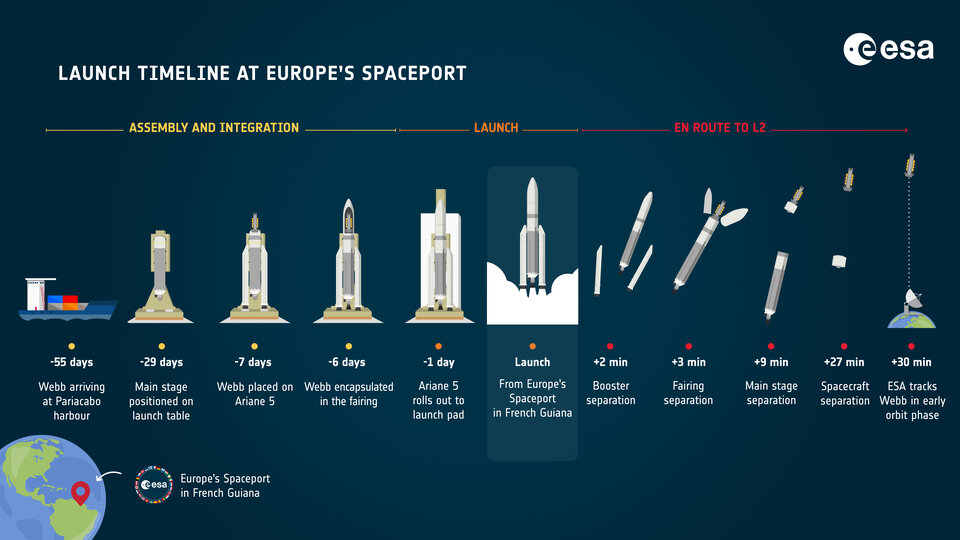Finally, it’s starting to get real for the James Webb Space Telescope. Engineers are now preparing the long-awaited landmark telescope for transport to its launch site at Europe’s Spaceport in French Guiana.
“NASA’s James Webb Space Telescope has reached a major turning point on its path toward launch with the completion of final observatory integration and testing,” said Gregory Robinson, Webb’s program director at NASA Headquarters. “We have a tremendously dedicated workforce who brought us to the finish line, and we are very excited to see that Webb is ready for launch and will soon be on that science journey.”
Final tests of the space telescope were conducted at Northrop Grumman’s facilities in California, making sure the complex, foldable observatory will operate as designed when in space. Packing and shipment operations have now begun, with precise steps necessary to ensure a safe journey down the coast of California, through the Panama Canal to reach French Guiana, on the northeastern coast of South America.
“We are glad about the completion of all tests for Webb and thank all the teams for their excellent work,” said Günther Hasinger, ESA Director of Science, in a press release. “We are really excited that all the items necessary for the launch are now coming together at Europe’s Spaceport,”
While shipment operations are underway, teams located in Webb’s Mission Operations Center (MOC) at the Space Telescope Science Institute (STScI) in Baltimore will continue to conduct simulations for both launch and operations of the telescope. Recently the team checked out the operations center and network and fully demonstrated that it is capable of seamlessly sending commands to the spacecraft. Now, the team will focus on conducting launch rehearsals, to prepare for all the possible contingencies of things that could go wrong – but hopefully right – during the launch and separation from the Ariane 5 launch vehicle.

As we reported earlier this year, the usually reliable Ariane 5 experienced problems on two previous launches in 2020 where unexpected vehicle accelerations occurred when the fairing separated from the rocket. The fairing is the nose cone used to protect a spacecraft payload during launch and acceleration through Earth’s atmosphere.
Officials from Arianespace said the origin of the problem was found and corrective actions have been taken. Indeed, an Ariane 5 successfully launched two commercial communications satellites on July 30, 2021, the first flight of the rocket in nearly a year, and the first of two missions scheduled before it can send Webb on its mission in space.
The next Ariane 5 launch is scheduled for no earlier than September, for a set of satellites (the SES-17 and Syracuse-4A satellites), and if successful, can then be followed by the launch for James Webb, likely no earlier than late November. NASA, ESA and Arianespace have not given a projected launch window, and for safety reasons have not divulged exactly when Webb will begin its journey to South America. However, below is a infographic of all the steps necessary for launch to take place:

The upper stage of the Ariane 5, which will carry Webb to space, is already on its way to Europe’s Spaceport.
After launch and a 26-minute ride to orbit, the spacecraft will separate from the rocket and its solar array will deploy automatically. If all goes well, the spacecraft will head out towards the second Lagrange point or L2, where it will actually orbit the Sun, 1.5 million kilometers (1 million miles) away from the Earth. This orbit lets the telescope stay in line with the Earth as it moves around the Sun and allows the satellite’s large sunshield to protect the telescope from the light and heat of the Sun and Earth (and Moon). It will take approximately 30 days to reach L2. Deploying and testing the entire telescope will take approximately six months, with several nail-biting events needing to go off without a hitch, including unfolding the sunshield and mirror, and setting up the antenna so all the data can be sent back to Earth. Webb will undergo an action-packed six-month commissioning period. Moments after completing a 26-minute ride aboard the Ariane 5 launch vehicle.
Lead image caption: With integration and testing formally concluded for the James Webb Space Telescope, NASA’s next giant leap into the cosmic unknown will soon be underway.Credits: NASA/Chris Gunn

